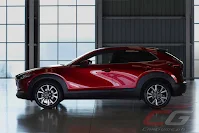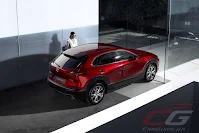The introduction of Mazda’s special colors—Soul Red Crystal Metallic and Machine Gray Premium Metallic didn’t just give the world two bold and distinct new shades, but it also helped Mazda develop new painting techniques—techniques which would give them a sort of hand-crafted feel that only master painters or Takuminuri could do.
Soul Red Metallic and Machine Gray Premium Metallic are different from conventional metallic colors in that they offer a deeper luster and depth. This was developed by stacking two layers—a layer responsible for color, and a layer responsible for reflection. In order to achieve what Mazda designers wanted—the interplay between light and shadow—the reflective layer is so precise that the embedded aluminum flakes must be light, small, and arranged horizontally. It’s for this reason that the reflective layer is made thin—about half that of the normal coating.
Of course, thinning the coating presents certain challenges. Chief among them is that any unevenness or difference in thickness that would otherwise be acceptable with conventional painting, would be visible. This pushed Mazda to re-think their entire painting process.
The vehicle painting process starts with an electrodeposition coating. This is where the entire assembled body is immersed in a huge tank to coat every nook and cranny. During this process, small particles (from welding) may stick to the surface, and this requires the process of sharpening to sand them off using the human eye, a special abrasive paper, and some elbow grease.
Typically, the quickest way sharpening method is done by rubbing in a front-to-back direction. However, because of the thin reflective coating, it leaves a visible mark. After some trial and error, production engineers realized that the only way to work on the new Takuminuri paint was through rotary sharpening which sharpens in a circular motion.
While this has solved one problem, they realized it was difficult to implement on the production floor since it’s more difficult to apply the right amount of pressure during rotary sharpening. Mazda’s solution was to retrain their people using pressure sensitive paper.
Even as Mazda finally got this part right, they noticed that rotary sharpening slows down the entire assembly process. In order to speed things up, they devised a sharpening booth, and even went so far as to re-examine the dust protection gloves worn by the sharpeners so they can detect and sharpen dust in just a second or two by look and by feel. Furthermore, they reviewed the entire painting process, valuing the “four cleanliness”—clean body, clean paint, clean drying oven, and clean booth. The end result is a higher quality paint finish, regardless of color.
It’s always difficult to bring a new color into mass production, more so if it has exacting requirements such as Soul Red Crystal Metallic and Machine Gray Premium Metallic. To that end, Mazda’s factory and production methodology rose up to the occasion by working together and solving problems as one. They’ve not just brought new colors to the world, but done so with the repeated confidence of mass production.










Are Mazda having problems with there soul Red Peint, Eg: chipping
ReplyDeleteThe paint is on the thin side from my experience. They're a good candidate for ceramic coating.
DeleteGetting anyone to do any respray work on the soul red crystal metallic is a nightmare most body shops won't touch it as its too complicated to try and match the colour.
ReplyDelete